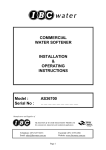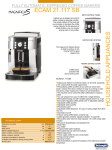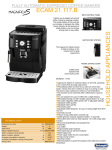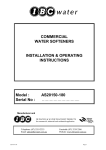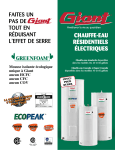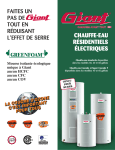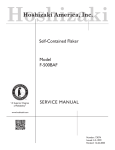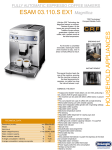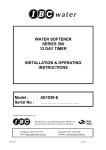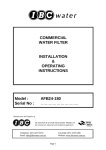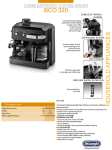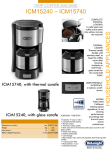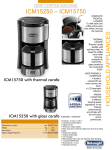Download COMMERCIAL WATER SOFTENER INSTALLATION
Transcript
COMMERCIAL WATER SOFTENER INSTALLATION & OPERATING INSTRUCTIONS Model : Serial No : AS30400 ……………………….. Manufacturer and Supplier of FILTRATION & WATER TREATMENT PRODUCTS for commercial, industrial and residential application Telephone: (07) 3219 2233 Email: [email protected] Facsimile: (07) 3219 2266 Website: www.ibcwater.com.au Page 1 INSTALLATION Check the equipment upon arrival for damage or shortages and report same to our Office or Agent before commencing installation. Locate the unit and brine tank on a firm level clean foundation, preferably concrete, with sufficient space for operation and maintenance. Position the tanks in their correct position before loading the media. MEDIA INSTALLATION Step 1: Remove the top tank flange/strainer assembly by unscrewing out the larger diameter flange and make sure the softener tank is empty and clean. It is recommended to utilise special ‘C’ type spanners available from I.B.C. Step 2: Bottom distributor assembly is pre-assembled and installed in the Softener Tank. Step 3: Place a 40mm or 50mm plastic pipe through the top hand hole that will reach to the bottom of the softener tank. Carefully pour the underbed gravel through this pipe so as not to damage the distributor assembly. Step 4: Pour in the underbed gravel (No.6) evenly around the tank, 120kg. Step 5: Level out the underbed gravel using a broom handle/PVC pipe. The underbed gravel should cover the bottom distributor by about 25mm. Step 6: Fill the tank with water to about 1/2 full of water. Step 7: Load the 400 litres of C100E resin. The resin is shipped in 25L bags. Step 8: Completely fill the tank with water. Step 9: Clean top of tank of all traces of resin. Step 10: Unpack the valve and pipe work, check that each union has its ‘O’ ring. Page 2 Step 11: Replace top tank/flange/strainer assembly (removed in Step 1) and tighten. Fit pipe work supplied and hand tighten each union. Check that main valve and pipe work is vertical, tighten all unions. Fit air release valve to the Tee at the top of the pipe work. Check all joints and flanges are tight. Do not overtighten. Step 12: Remove the lid of the brine tank and remove the brine tube (black poly flexible tubing). Connect the brine tube to the throttle/stop valve on the main control valve. Step 13: Remove the brine valve from the brine well of the brine tank. Ensure brine tank is free from foreign matter and set brine valve and float height as follows:Determine if wet salt or dry salt is required, using the formula shown in “Determining Frequency of Regeneration”. If sufficient information is not available to do the calculations shown in “Determining Frequency of Regeneration”, contact our office. The brine valve is supplied factory fitted with a dry salt riser, a wet salt riser is also supplied (short black screwed riser pipe - refer Fig. 19). Store the riser tube not used, DO NOT DISCARD it may be needed at commissioning. Step 14: Replace the brine valve in the brine well and connect brine tube - this tube is supplied long and can be cut to the desired length. Step 15: Now add the No 4 gravel to the brine tank (120kg - 6 bags) and level. Ensure no gravel enters brine well - add salt to the tank (refer Table 7 for correct quantity), replace lid. Step 16: Plumb the unit, noting the following:a) Check arrow markings on the valve for correct inlet/outlet plumbing (Fig.1). b) Use minimum 50mm pipe size. c) Fit a pipe union to drain line for ease of access for maintenance or cleaning. d) Install inlet and outlet isolating valves and a Manual Bypass Valve (if desired). e) Install optional water meter if required. f) Connecting pipe work and valves MUST be supported to prevent loading on the valve and pipe work. Before connecting pipe work, flush all lines, close inlet, outlet and bypass valve. Page 3 g) The drain line must discharge into an open pipe at least 80mm diameter no more than 3 metres from the unit. An air gap of 100mm should be allowed for inspection and to conform to sanitary codes. Connect the 172 Valve actuator drain line to the waste with 10mm tubing. h) Power supply is required not more than 0.5 metres from the unit and should be a 3 pin 10a 240v 50Hz GPO preferably earth leakage protect. Total power draw, 13 watts maximum. i) Minimum operating pressure 205 kPa (30psi), maximum operating pressure 690 kPa (100psi). If supply pressure is above 690 kPa, fit pressure reducing valve. This must be a non-fluctuating supply. Maximum temperature of 58°C j) Slowly fill Softener Tank with water by placing control valve in backwash position, turn off inlet isolating valve when tank fully vented of air. Refer to start up procedure Page 4, of 172 Valve Installation, Operation & Maintenance Manual. Page 4 DETERMINE FREQUENCY OF REGENERATION After locating and installing the brine tank in the required position, it is necessary to know whether a wet or dry salt system is being used. This is done by calculation as follows:NOTE: Less salt is required to regenerate a partially exhausted bed per gram of hardness removed, than that required for a more exhausted bed. For economy sake, regenerate before full exhaustion. Calculate time between regenerations thus:C ----------HxQ = N Where C = maximum capacity of unit as grams of CaCO3 = 28000 grams. H = hardness of water a mg/l or ppm. Q = amount of water passed through the unit in kilolitres per day. N = maximum time between regenerations in days. The calculated value of N should be taken down to the nearest whole number. This is the maximum number of days, which can be achieved between regenerations. The amount of salt needed per regeneration, is calculated thus:Total hardness removed Where A = = NxHxQ=A the total hardness removed as grams of CaCO3 The salt dosage is found on Table 4. Page 5 EXAMPLE Unit AS30400 Litres of resin “400” from Table 4 Hardness of water 90 mg/l Flow 15kl/hr for 18 hours /day. Q = 15 x 18 = 270 kl/day H = 90 mg/l or ppm C = 24300 grams (= 270 x 90) Frequency of regeneration - N = C ------------HxQ = 24300 ------------90 x 270 = 1.0 day Always go down to the nearest whole number (say 1 day). Total hardness removed A = = = NxHxQ 1 x 90 x 270 24300 grams The medium and maximum capacities of a single unit from Table 4 are 21000 and 28000 respectively. The calculated capacity falls closer to the maximum and so the higher value should be used. Salt dosage required per single softener for 28000 g is 96 kg (from Table 4). Now looking at Table 5 we find that only wet salt can be used. However, if your calculated salt dosage allows you the choice of either dry or wet salt always choose dry salt. In the case of the example the salt dosage is 96 kg so the float setting is 350mm (refer Brine Tank Set-up for float setting details), brine tank size is 1070 x 1220. Install the brine valve as shown in Brine Tank Set-up. The initial salt load as shown in Table 7 should be loaded into the brine tank. Page 6 IMPORTANT NOTE: The water softener, as supplied, has the brine riser pipe assembled to suit dry salt brine system. If, however, on reference to Table 5 you find that wet salt must be used, then wet salt brine rise pipe (short black pipe piece supplied) must be fitted to the brine valve. Note: For wet salt it is very important that the salt level be maintained in line with the brine valve. As illustrated in the brine tank setup sheet, the salt used per regeneration must be replenished at least 4 hours before the next regeneration. Page 7 COMMISSIONING Step 1: Check plug is dry first, then connect lead into power outlet and switch on. Check that the brine throttle/stop valve is closed. Step 2: Fully open the control valve electrical cabinet cover and hold in this position with a temporary tie cord. Depress the red knob (Fig. 5) and rotate anti-clockwise to backwash position, release red knob, wait for valve drive to index to backwash position. (if not already in this position). Depress red knob and rotate anti-clockwise to brine position, release, wait for valve drive to index to brine position. Depress red knob and rotate to brine refill purge position and release. Step 3: Just open inlet isolating valve approximately 1.1/2 turns. Allow unit to fill slowly (water will issue to drain) continue to run until the unit automatically indexes to Service position which may take up to 10 minutes. All air must be removed. Step 4: Open brine throttle/stop valve approximately 1.1/2 turns, fully open inlet isolating valve. Open the cold water isolating valve and allow brine tank to fill until brine float valve shuts off. A period of four (4) hours soaking should elapse after filling with water before commissioning to allow the brine to saturate. Depress the red knob and turn anti-clockwise to start, release, the unit will now go through each cycle - Backwash, brine rinse, purge and back to service automatically, the full cycle will take approximately 90 minutes. NOTE: A small amount of media may pass to drain during the initial backwash, this is considered normal. When unit commences brine and rinse cycle, adjust brine throttle/stop valve to the correct draw down rate. The draw down rate is determined by dividing the float setting height, selected from Table 5, by 20. eg if 300mm is the float height selected, the draw down rate is 15mm per minute. Draw down is measured with a tape measure in the brine well, and is the distance in ‘mm’ that the brine level drops in one minute. Step 5: Check with site supervisor that unit can go on line. If so - slowly open outlet isolating valve fully, check that manual bypass valve is fully closed. This unit is now on line. Step 6: Check for and report any leaks. Go to nearest tap, now on soft water, open and allow to flow for a few minutes. Using test kit to test for soft water - refer testing in back of these instructions. It may take several minutes for the soft water to pass to the tap. If hard water persists refer to the Service hints in these instructions. Check that the brine tank is full and that the float has shut off. Page 8 Step 7: In the calculations you have done (determining regeneration frequency) you found the value for (N) - maximum time between regeneration in days. To set the skipper wheel up as required, pull all the skipper wheel pins (Fig. 5) out. Turn the dial to the correct day of the week on which you are setting the dial. Now depress the pins for the desired day/s for regeneration/s required. If no data is available to do the calculations at this stage then set regeneration for every second day. When setting the regeneration frequency you should take into account the working days, for instance if the installation will only work week days, regeneration on Friday and Monday would be a needless waste of salt. Always set in accordance with the duty conditions for maximum economy. NOTE: This is only a guide for initial setting and should be altered to suit each individual installation in accordance with load conditions - do the calculations in determining frequency of regeneration, it will help you in understanding the softener. Step 8: Set time of day, pull timer knob (Fig. 5) and set arrow to the time of day (time of your watch) release, make sure that the knob has re-engaged gear, knob right in. Step 9: Replace the timer cover, wipe over unit. Do final check for leaks etc. Page 9 HARDNESS TEST 1. Water to be tested should be taken from a tap after the water softener 2. Measure 10ml of water into plastic bottle supplied (approximately 1/3 full) 3. Add one Yes/No tablet to sample water, replace cap and shake until tablet has completely dissolved. (NOTE: do not handle Yes/No tablet with fingers) 4. The final colour to be obtained for soft water is green. (Note: The shade of green may vary.) If the colour turns red, the water is above 20mg/l hardness, therefore another regeneration is recommended. 5. Rinse plastic bottle after each test has been completed. 6. When used as above, the tablets change the colour from green to red at a hardness of approximately 20ppm based on a sample volume of 10mls. Other hardness test kits are available for more accurate testing eg. Hardness Tablets Directions: Take a 50ml sample of water in a screw capped bottle. Add one (1) tablet to sample, shake or crush to disintegrate. Repeat until last trace of reddish tinge disappears. The final colour is usually blue but with some water a greyish coloured end point is obtained. Using 50ml sample Hardness ppm = (number of tablets x 40) - 20 LR (BW) Tablets Directions: Take a 100ml sample of water in a screw capped bottle. Add one (1) tablet to sample, shake or crush to disintegrate. Repeat until last trace of reddish tinge disappears. The final colour is usually blue but with some water a greyish coloured end point is obtained. Using 100ml sample Hardness ppm = (number tablets x 2) - 1 Contact IBC Water Treatment if further details are required. Page 10 PERFORMANCE DATA Capacity & Salt Dosage Model No. AS30400 Service Flow Rate Pipe Size Minimum Maximum Peak Flow Continuous Flow Inlet Outlet Drain grams/kg grams/kg l/m l/m mm mm 14000/26 28000/96 350 265 50 40 Resin Volume Approx. Shipping Weight Space Requirements Litres wt/kg W xDxH metres 400 830 1.8x1.2x2.6 Peak flow not recommended for extended periods of time. Brine Tank: 1000 litre L.D.P.E. moulded construction complete with lid. Brine Valve: Plastic construction. Operation Pressure: 210 - 600 kPa Temperature: 5 - 50 degrees C Electrical: 240v 50Hz 3w maximum WARNING: A pressure reduction valve should be installed in areas of high water pressure (above 690 kPa). A water hammer arrester should be installed if water hammer prevails. FAILURE TO OBSERVE WARNINGS WILL VOID WARRANTY Table 3 MEDIA LOADING Model Underbed Gravel No.6 kg Resin Content litres Brine Tank Gravel No.4 kg AS30400 120 400 120 Page 11 Table 4 Grams capacity and salt dosage - grams as CaCO3 / salt kg Model AS30400 Resin Minimum Medium Maximum litres grams/kg grams/kg grams/kg 400 14000/26 21000/53 28000/96 Table 5 Float settings (mm) Salt Dosage (kg) Brine Tank Size 1070 x 1220 Dry 270 335 420 460 545 625 670 - 32 40 50 55 65 75 80 90 95 110 120 Wet 110 135 170 185 215 250 270 300 320 370 405 Table 6 Specification flow rate - lpm - nominal only. Model Backwash Brine Slow Rinse Fast Rinse AS30400 95 33 25 95 Table 7 Model AS30400 Initial Salt Loading - Kgs Dry Wet 800 Page 12 275 BRINE TANK SETUP Page 13 Page 14 Series 172 Commercial / Industrial Control System Water Softener Page 15 START-UP PROCEDURE Includes procedures to pressurise softener tank and fill brine tank With all piping and installation completed, and with mineral in the tank, proceed as follows: 1. Disconnect electrical power to timer. 2. Remove valve cover to expose timer and mechanism. 3. Open manual bypass valve, close manual inlet and outlet valves (see Figure 2). 4. Push in on RED KNOB on timer, turn counterclockwise until arrow on the camshaft/timer support points to the BACK-WASH position indicated on #1 cam (see Figure 5). 9. Fill the brine tank with the proper amount and type of salt recommended for the use with the system. 10. Push in RED KNOB and index pilot valve to PURGE. Allow water to flow to drain until clear. During this time the brine tank will fill until the float closes the brine tank valve. Check that all the brine fittings are tight and that water level in brine tank os according to softener specifications. 11. Index the valve to SERVICE. 12. Close manual by-pass valve and open outlet valve fully. Figure 6 Figure 5 Set Timer 5. Slowly open manual inlet supply valve. DO NOT open fully. Water will enter from the bottom of filter tank as air is expelled from the top to the drain. Full flow of water could cause loss of media. Continue to fill slowly until air is expelled and only water flows to drain. NOTE: If top cover of softener tank can be removed to vent air, the tank may be filled more quickly. Observe the level and replace cover before tank overflows. 6. When ONLY water flows to drain, open inlet valve fully and backwash until water looks clean when caught in a container. 7. Push in RED KNOB and index timer counterclockwise to BRINE/RINSE position (arrow on camshaft/timer support pointing to BRINE/ RINSE on #1 cam). Observe a slow flow of water to the drain. 8. Push in RED KNOB and index timer to PRESSUR. (pressurise) position indicated on #1 cam (see Figure 6). Keep in this position for 5 minutes. This allows the tank to return to line pressure and permits easier movement of the valve discs. Determine a regeneration schedule for the softener and adjust the automatic timer (see Figure 9) as follows: 1. Put all SKIPPER PINS up (away from control). 2. Rotate SKIPPER WHEEL until DAY ARROW points to day of week. 3. Depress SKIPPER PIN(S) for day(S) regeneration is required. 4. Pull TIMER KNOB out (away from timer face) and rotate until BLACK ARROW on tripper arm points to correct time of day on Face Plate. 5. Timer will automatically initiate backwash on preset days at 2:30 A.M. To alter time, simply reset TIMER KNOB to an earlier or later time which will change the time of regeneration by the same number of hours. (Time indicated at BLACK ARROW will no longer be correct). Set BACKWASH timing (Figure 7) Make sure time is in the SERVICE position. Loosen the screw (A) on the white gear (B) and rotate the grey gear (C) with the numbered decal until desired Page 16 time (3, 6, 9, 12, 15, 27 minutes) aligns with pointer on box (D). Tighten the screw on the white gear. (pressurise) position pause for at least 5 minutes or until tank is pressurised. Final check-out 1. Test for soft water from a convenient soft water tap. 2. Manual by-pass valve must be closed (see Figure 2). 3. Manual inlet and outlet valves open (see Figure 2). 4. Brine line shut-off valve open (see Figure 4) 5. Drain line clear and unobstructed. 6. Electrical power to timer (not controlled by switch). 7. Time of day, frequency of regeneration, backwash timer and brine/rinse time set properly. 8. Proper liquid level in the brine tank and supply of salt. Figure 7 Set PURGE timing (Figure 8) Make sure timer is in the SERVICE position. Loosen the screw (E) on the grey gear (F) with the pointer until the pointer aligns with the desired time (5-35 minutes). Tighten the screw. Figure 9 Figure 8 MANUAL OPERATION A. Start-Up or inspection regeneration. B. Manual initiation of regeneration. 1. Disconnect electrical power. 1. Reconnect electrical power. 2. Push the RED KNOB and turn counterclockwise past START to BACKWASH. Leave in position for desired time. 2. Push in RED KNOB and turn counterclockwise to the START position. Release. Unit will then go through a complete regeneration as programmed. 3. Push in RED KNOB and repeat for all desired cycles. NOTE: At PRESSUR. Page 17 Flow Diagrams PUSH/PULL ROD 6 OUTLET VALVE DISC 5 BY-PASS 4 DRAIN 3 BACKWASH 3 BACKWASH VALVE CLOSED VALVE OPEN 1 INLET Page 18 2 BRINE Page 19 Page 20 Figure 10 Figure 11 Three pressure taps are available on the Pilot Valve for use in actuating external diaphragm valves. Pressure TAP No. 2 will give a pressure signal during SERVICE, BRINE, RINSE, PURGE and BRINE REFILL cycles; pressure TAP No. 3 will give a pressure signal during BACKWASH cycle; and pressure TAP No. 7 will give a pressure signal throughout the entire REGENERATION cycle. Before attaching a ¼ " (6.2 mm) tube to any pressure tap, drill out the barrier in the tap using a ⅛" (3.1 mm) drill. Use a ¼ " (6.2 mm) plastic ferrule nut to make the connection. Insert the drill into the opening of the tap and drill the hole in the barrier being careful not drill through the backwall of the tap. Page 21 GENERAL SPECIFICATIONS Figure 15 Hydrostatic test pressure ……………………………………………………………………………………………. 250 psi (17.2 bar) Working pressure ……………………………………………………………………………………….. 20 - 100 psi (1.38 - 6.89 bar) Standard electrical rating ……………………………………………………………………………………………………. 120V/60Hz Optional standard electrical rating (Timers) ………………………………..……… 24V/50Hz, 120V/50Hz, 24V/60Hz, 24V/50Hz Electrical cord (when furnished …………………….………………………………………………….. 6" (150 cm), 3 wire with plug Electrical Connection ………………………………………………………… 1/2" (1.3 cm) conduit opening. Terminal strip inside Standard plumbing connection …………………..……………… 2 in NPT inlet, outlet top and bottom of tank; 1-1/2" NPT drain Union type fittings for inlet, outlet Top and bottom tank ……………………………………...… 2" brass pipe with o-ring seal to valve. Available in standard (NPT) or optional (BSPT) threads. Also available in PVC Rubber parts ………………………………………………………………………………………... Compound for cold water service Control body ……………………………………………………………………………………... Fibreglass reinforced thermoplastic Page 22 Page 23 TIMING GEAR ASSEMBLY Important: When assembling or disassembling the timer gear assembly, the 172 Control must be in the SERVICE position. 1. Position Part No. 172D45 as shown. Part numbers are moulded into each part 2. Place Part No. 172D46 on Part No. 172D45 so that white (underside) arrow points to 44 minutes on the BRINE/RINSE timing to desired time (22-62 minutes) after reassembly, appear on page 5 of bulletin 172 O.M 3. 4. Place the tree-part timing gear assembly on the timer mounting bracket, Part No. 172D34, as shown so the edge of the white piece is aligned left of the screw boss in the timer mounting bracket. 5. Assemble the 172B36 gear to the 172B39 support so that the deepest of the four slots in the sleeve of the gear is oriented as shown. Position the gear/support assembly over the timing gear/mounting bracket assembly; insert the three phillips head screws and tighten With Parts No. 172D45 and 172D46 together, insert Nos. 22A354-001 and 172D44 as shown. Page 24 REPLACEMENT PARTS Page 25 VALVE ASSEMBLY PARTS LIST Item Description No. Required Item 1H-1 Valve Body NPT 1 19H 1H-2 2H-1 2H-2 3H-1 3H-2 4H-1 Valve Body BSPT Adapter - 2" PVC Adapter - 63 mm PVC Adapter - 2" NPT brass Adapter - 2" BSPT Brass Nut - for 2" NPT, 2" BSPT & 2" PVC Adapter Nut - for 63mm PVC Adapter O-ring Valve Disc #1 & #6 Valve Disc #2 Valve Disc #3 & #4 Valve Disc #5 Screw Cap - Large Cap - Small Spring - Large Spring - Small Push/Pull Rod Piston - Large Piston - Small Diaphragm - Large Diaphragm - Small Plate - Large Plate - Small Washer Screw Screw U-Nut O-ring 1 4 4 4 4 20H 21H 22H 23H 24H 25H 4H-2 5H 6H-1 6H-2 6H-2 6H-4 7H 8H-1 8H-2 9H-1 9H-2 10H 11H-1 11H-2 12H-1 12H-2 13H-1 13H-2 14H 15H 16H 17H 18H 4 4 4 2 1 3 1 26 3 4 3 4 7 3 4 3 4 3 4 7 7 2 2 1 27H 28H 28H-1 29H 30H 31H 33H 34H 35H 36H 37H 38H 39H 40H 41H 43H 44H 45H 46H 52H 53H 54H 55H 888D Page 26 Description Injector-Specify AA, BB, CC OR DD O-ring Injector screen O-ring Injector Cap Screw - Timer Timer - Specific Voltage: Frequency; 6 or 7-day Timer Mounting Bracket Timing gear Timing gear assembly Screw - Timing Gear Screw - Pilot Valve Pilot Valve Body Connection Screw - Small Cap, Top Valve Disc - Pilot Gear - Timing Spring Locking Arm Support - Camshaft & Timer Screw Camshaft Assembly Camshaft Support Rocker Arm Shaft Assembly Spring - Inlet Spring - Drain Cover Nut - Tube Tube Tube Elbow - Tube Filter - Pilot Valve No. Required 1 1 1 1 1 3 1 1 1 1 2 5 1 4 7 1 1 1 1 3 1 1 1 1 7 1 1 1 1 TIMER REPLACEMENT PARTS Item 14F-6 14F-7 85F 89F 15F 85F 88F Description 6-Day skipper wheel assembly 7-Day skipper wheel assembly Screw Plastic washer Bowed washer Screw Plastic washer No. Required 1 1 2 1 1 1 1 Item 87F 99F-3 99F-4 120H 18F 19F 123H Page 27 Description Spring 6-Day tripper gear 7-Day tripper gear Motor - specify voltage; frequency Screw - motor mounting Wire nut Cord No. Required 1 1 1 1 2 2 1 TROUBLE SHOOTING Symptom Control will not regenerate automatically. No brine draw. Salt in water. Intermittent brine draw. Hard water after regeneration. Possible cause a. b. c. a. b. c. d. e. No skipper pins in. No power. Motor burned out. Clogged injector / screen. Low water pressure. Obstructed drain line. Closed valve in brine line. Valve disc No. 1 not closed. a. Check for "No brine draw" as in steps (a) through (e) above, plus b. Brine rinse time set too low. Solution a. b. c. a. b. c. d. e. Push in skipper pins. Check time of day and power. Replace motor. Clean. Pressure must be above 20 psi. Eliminate back pressure. Check and open. Flush seat by manually operating No. 1 pilot valve disc. a. As in steps (a) through (e) above. b. Increase toward 62-minute time. a. Low pressure. b. Clogged injector / screen. a. Set up pressure. b. Clean or replace as required. a. Unit out of salt.. b. Bypass (manual) open. c. Valve disc No. 5 open. a. Add salt and regenerate. b. Close. c. Flush seat by manually operating No. 5 pilot valve disc. d. Add resin and locate reason for loss. d. Loss of resin. Backwash rate extremely low or high. a. Plugged flow controller (low). b. Flow controller rubber insert missing (high). a. Clean. b. Replace. Water dripping to drain in service. a. One or more valve discs not seated. a. Flush seats by manually operating No. 3 and No. 4 pilot valve discs Chattering during regeneration. a. Excessive flow rate through bypass. a. Regenerate at time when flow rate is lower. Page 28




























